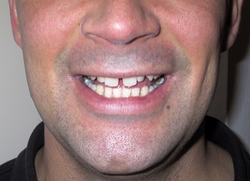Diastema
This article needs additional citations for verification. (April 2018) |
| Diastema | |
|---|---|
 A person with space between the two front teeth | |
| Details | |
| Identifiers | |
| Latin | diastema |
| MeSH | D003970 |
| TA98 | A05.1.03.078 |
| TA2 | 904 |
| FMA | 77271 |
| Anatomical terminology | |
A diastema (plural diastemata) is a space or gap between two teeth. Many species of mammals have diastemata as a normal feature, most commonly between the incisors and molars. Diastemata are common for children and can exist in adult teeth as well. Diastemata are primarily caused by imbalance in the relationship between the jaw and the size of the teeth.
In humans[]
In humans, the term is most commonly applied to an open space between the upper incisors (front teeth). It happens when there is an unequal relationship between the size of the teeth and the jaw. Diastema is sometimes caused or exacerbated by the action of a labial frenulum (the tissue connecting the lip to the gum), causing high mucosal attachment and less attached keratinized tissue. This is more prone to recession or by tongue thrusting, which can push the teeth apart.[1]
Treatment[]
1. Determining the cause of the diastema, then treat the cause.
2. Diastema treatment options can differ from one patient to another, but generally it is treated by orthodontics,[2] or composite fillings, or a combination of veneers or crowns.
Historical and popular culture references[]
In The Canterbury Tales, Geoffrey Chaucer wrote of the "gap-toothed wife of Bath".[3] As early as this time period, the gap between the front teeth, especially in women, was associated with lustful characteristics.[4] Thus, the implication in describing "the gap-toothed wife of Bath" is that she is a middle-aged woman with insatiable lust.[4] This has no scientific basis, but it has been a common premise in folklore since the Middle Ages.[citation needed]
In Ghana, Namibia, Nigeria as well as through out many communities in Kenya, diastemata are regarded as being attractive and a sign of fertility, and some people have even had them created through cosmetic dentistry.[5] In France, they are called "dents du bonheur" ("lucky/happiness teeth").[6] This expression originated in Napoleon's time: when the Napoleonic army recruited, it was imperative that soldiers had incisors in perfect condition because they had to open the paper cartridges (containing powder and ball) with their teeth when loading their muskets. All those who had teeth apart were then classified as unfit to fight. Some men broke their own teeth to avoid going to war.[citation needed] Les Blank's Gap-Toothed Women (1987) is a 30 minute documentary film about diastematic women.[7]
Famous people[]

Some well-known people noted for having diastema include:
- musicians Charley Pride, Ray Davies of The Kinks, Billy Preston, Ray Dorset of Mungo Jerry, Elvis Costello; Madonna, Dave Brockie a.k.a. Oderus Urungus and guitarist Corey Smoot a.k.a. Flattus Maximus, both of GWAR, Melanie Martinez, Becky G, Amy Winehouse, Laura Pausini, Edmund Sylvers, Elton John, Hayley Williams, Mac DeMarco, Seal, Flea, 50 Cent, Pharoahe Monch, guitarist Steve Howe, and singer Bobby Brown and his daughter Bobbi Kristina Brown;[8]
- models Jessica Hart, Michele Achieng Opiyo, Lindsey Wixson, Lauren Hutton,[9] Georgia May Jagger,[4] Slick Woods and Lara Stone;
- American television news reporter and anchor Michelle Charlesworth;
- American football player Patrick Mahomes and Michael Strahan; association football player Ronaldo;
- French tennis player Yannick Noah;
- British Formula 1 World Champion Lewis Hamilton;
- actresses Vanessa Paradis, Léa Seydoux, Amira Casar, Eve Myles, Cécile de France, Brigitte Bardot, Béatrice Dalle, Jorja Fox, Anna Paquin and Uzo Aduba, Octavia Spencer
- actors Ernest Borgnine, Terry-Thomas, Jemaine Clement, Willem Dafoe, Elijah Wood and Jamaica's Keith 'Shebada' Ramsay; former late night TV show host David Letterman; antiques expert and TV personality Tim Wonnacott;
- comedians Jimmy Tarbuck "The Gap-Toothed Chuckle Chappy", Paul F. Tompkins,[10] and Alan Carr;
- New Zealand television news anchor and actress Angela D'Audney
- professional wrestler and former TNA World Heavyweight Champion Bobby Roode; Major League Baseball player Jimmy Rollins;
- Politicians and leaders including American politician Stacey Abrams, former U.S. Secretary of State Condoleezza Rice.;[3][5] former Supreme Court Justice Sandra Day O'Connor,[4] and, according to released photos, several of the children of Nicholas II of Russia.

References[]
| Wikimedia Commons has media related to Diastema (dentistry). |
- ^ "Diastema or Gaps Between Teeth: Causes and Solutions". Orthodontics Australia. 2020-06-29. Retrieved 2021-03-20.
- ^ Wheeler, Bryan; K. Carrico, Caroline; Shroff, Bhavna; Brickhouse, Tegman; Laskin, Daniel (2017-11-01). "Management of the Maxillary Diastema by Various Dental Specialties". Journal of Oral and Maxillofacial Surgery. 76 (4): 709–715. doi:10.1016/j.joms.2017.11.024. PMID 29245001.
- ^ Jump up to: a b Rachel Dodes (September 8, 2010). "We Don't Mind the Gap: The Fashionable Flash a New Smile". The Wall Street Journal. Retrieved 2010-09-10.
- ^ Jump up to: a b c d Garmaise, Ariella (2018-04-04). "Gap-Toothed Women". The McGill Tribune. Retrieved 2019-09-09.
- ^ Jump up to: a b "Midline diastemata in fashion". Bite magazine website. October 14, 2010. Archived from the original on April 20, 2012. Retrieved September 10, 2010.
- ^ McGuiness, Romina (December 8, 2010). "The year of the gap-tooth trend". Metro. Archived from the original on March 8, 2012. Retrieved April 17, 2013.
- ^ Canby, Vincent (1987-09-16). "Film: 'Gap-Toothed Women,' 'Miss . . . or Myth?'". The New York Times. ISSN 0362-4331. Retrieved 2019-09-09.
- ^ Gary Hill. "Steve Howe". AllMusic. Retrieved July 23, 2014.
- ^ Ebert, Roger. "Gap-Toothed Women Movie Review (1988)". Roger Ebert. Retrieved 2019-09-09.
- ^ "Diastema (dentistry)". Factualworld. Retrieved 3 Apr 2014.
- Vertebrate anatomy
- Human anatomy
- Teeth
- Developmental tooth pathology